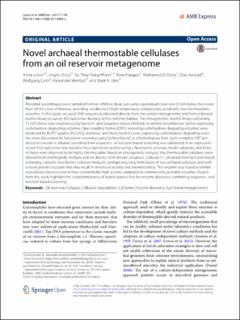| dc.contributor.author | Lewin, Anna | |
| dc.contributor.author | Zhou, Jinglie | |
| dc.contributor.author | Pham, Vu Thuy Trang | |
| dc.contributor.author | Haugen, Tone | |
| dc.contributor.author | El Zeiny, Mohamed | |
| dc.contributor.author | Aarstad, Olav Andreas | |
| dc.contributor.author | Liebl, Wolfgang | |
| dc.contributor.author | Wentzel, Alexander | |
| dc.contributor.author | Liles, Mark R. | |
| dc.date.accessioned | 2020-12-22T13:35:12Z | |
| dc.date.available | 2020-12-22T13:35:12Z | |
| dc.date.created | 2017-12-11T12:38:11Z | |
| dc.date.issued | 2017 | |
| dc.identifier.citation | AMB Express. 2017, 7 (183), . | en_US |
| dc.identifier.issn | 2191-0855 | |
| dc.identifier.uri | https://hdl.handle.net/11250/2720811 | |
| dc.description.abstract | Microbial assemblages were sampled from an offshore deep sub-surface petroleum reservoir 2.5 km below the ocean floor off the coast of Norway, providing conditions of high temperature and pressure, to identify new thermostable enzymes. In this study, we used DNA sequences obtained directly from the sample metagenome and from a derived fosmid library to survey the functional diversity of this extreme habitat. The metagenomic fosmid library containing 11,520 clones was screened using function- and sequence-based methods to identify recombinant clones expressing carbohydrate-degrading enzymes. Open reading frames (ORFs) encoding carbohydrate-degrading enzymes were predicted by BLAST against the CAZy database, and many fosmid clones expressing carbohydrate-degrading activities were discovered by functional screening using Escherichia coli as a heterologous host. Each complete ORF predicted to encode a cellulase identified from sequence- or function-based screening was subcloned in an expression vector. Five subclones was found to have significant activity using a fluorescent cellulose model substrate, and three of these were observed to be highly thermostable. Based on phylogenetic analyses, the thermostable cellulases were derived from thermophilic Archaea and are distinct from known cellulases. Cellulase F1, obtained from function-based screening, contains two distinct cellulase modules, perhaps resulting from fusion of two archaeal cellulases and with a novel protein structure that may result in enhanced activity and thermostability. This enzyme was found to exhibit exocellulase function and to have a remarkably high activity compared to commercially available enzymes. Results from this study highlight the complementarity of hybrid approaches for enzyme discovery, combining sequence- and function-based screening. | en_US |
| dc.language.iso | eng | en_US |
| dc.publisher | Springer | en_US |
| dc.rights | Navngivelse 4.0 Internasjonal | * |
| dc.rights.uri | http://creativecommons.org/licenses/by/4.0/deed.no | * |
| dc.subject | Functional metagenomics | en_US |
| dc.subject | Enzyme discovery | en_US |
| dc.subject | CAZymes | en_US |
| dc.subject | Cellulose degradation | en_US |
| dc.subject | Cellulase | en_US |
| dc.subject | Oil reservoir | en_US |
| dc.title | Novel archaeal thermostable cellulases from an oil reservoir metagenome | en_US |
| dc.type | Peer reviewed | en_US |
| dc.type | Journal article | en_US |
| dc.description.version | publishedVersion | en_US |
| dc.rights.holder | © The Author(s) 2017. This article is distributed under the terms of the Creative Commons Attribution 4.0 International License
(http://creativecommons.org/licenses/by/4.0/), which permits unrestricted use, distribution, and reproduction in any medium,
provided you give appropriate credit to the original author(s) and the source, provide a link to the Creative Commons license,
and indicate if changes were made. | en_US |
| dc.source.pagenumber | 17 | en_US |
| dc.source.volume | 7 | en_US |
| dc.source.journal | AMB Express | en_US |
| dc.source.issue | 183 | en_US |
| dc.identifier.doi | 10.1186/s13568-017-0485-z | |
| dc.identifier.cristin | 1525610 | |
| cristin.unitcode | 7401,80,61,0 | |
| cristin.unitname | Bioteknologi og nanomedisin | |
| cristin.ispublished | true | |
| cristin.fulltext | original | |
| cristin.qualitycode | 1 | |

